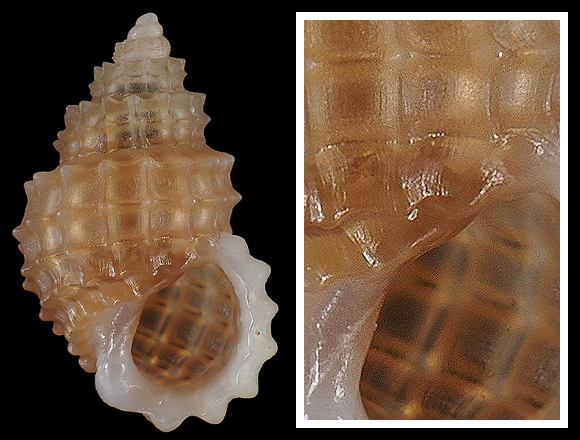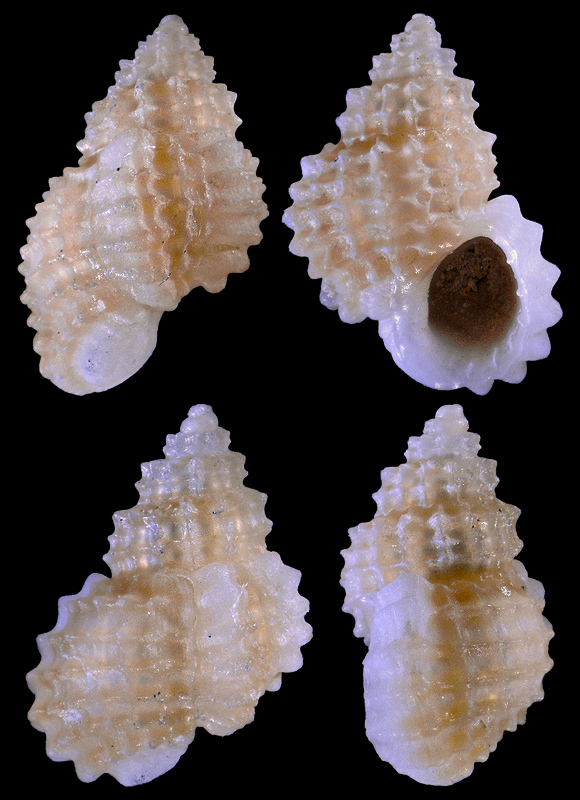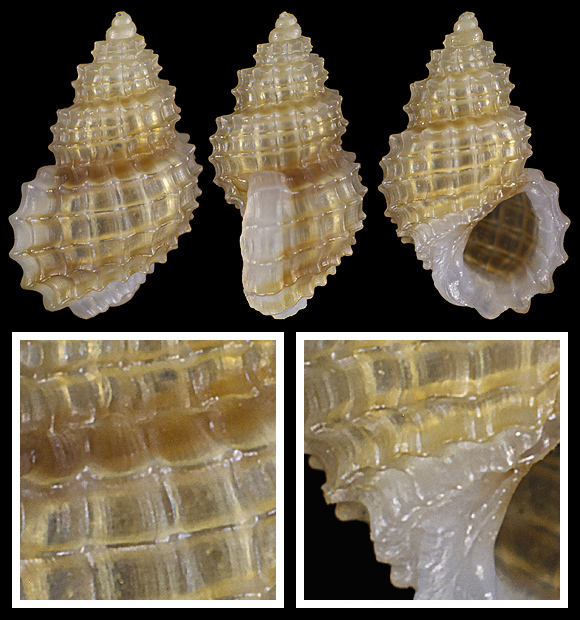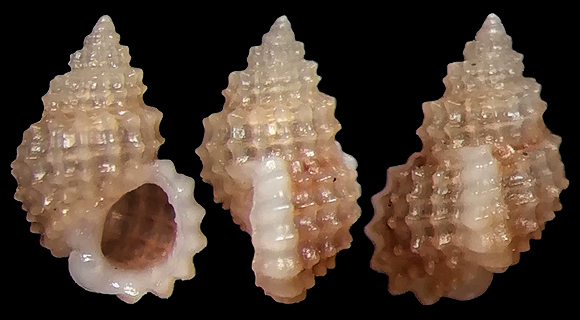
Iceland to Sea of Barents, to Canarias; Azores and lusitanian seamounts to Mediterranean. From low tide to 50m deep. Grazer and detritus feeder. Protonym: Turbo cancellatus.
« Shell conic-oval, solid, opaque, somewhat glossy. Sculpture: strong longitudinal ribs, 16 of which are on the body-whorl, 15 on the penultimate, 14 on the succeeding whorl, […] there are also equally strong spiral ribs, 6 of which are on the body-whorl, 3 or 4 on the penultimate, and 2 only on each of the succeeding three whorls ; the first two or three whorls […] exhibit extremely fine and numerous longitudinal wavy striae ; the two sets of ribs cross each other, leaving between them square cavities and forming at the points of intersection raised and rather sharp tubercles, imparting to the surface a prickly aspect ; labial rib broad, and traversed by the spiral ribs up to the mouth, the edge of which consequently becomes scalloped or indented. » – J. G. Jeffreys: British conchology vol. IV, London 1867, p.8.
« Shell conic-oval, solid, opaque, somewhat glossy. Sculpture: strong longitudinal ribs, 16 of which are on the body-whorl, 15 on the penultimate, 14 on the succeeding whorl, […] there are also equally strong spiral ribs, 6 of which are on the body-whorl, 3 or 4 on the penultimate, and 2 only on each of the succeeding three whorls ; the first two or three whorls […] exhibit extremely fine and numerous longitudinal wavy striae ; the two sets of ribs cross each other, leaving between them square cavities and forming at the points of intersection raised and rather sharp tubercles, imparting to the surface a prickly aspect ; labial rib broad, and traversed by the spiral ribs up to the mouth, the edge of which consequently becomes scalloped or indented. » – J. G. Jeffreys: British conchology vol. IV, London 1867, p.8.
44m deep, southern coast of Šolta island, Split-Dalmatia Comitat, S. Croatia. 3,3mm. Original picture provided by R. Stanić (HR) – (CC BY-NC-SA).

« Colour yellowish-white, with often more or less of a rufous tinge, or indistinctly marked by two reddish-brown bands, a narrow one below the suture and a broad one round the periphery ; sometimes the colour is milk-white ; the throat or inside of the mouth is frequently stained by reddish-brown. Spire short and acute. Whorls 6-7, convex, the last occupying two-thirds of the total length ; the first two or three whorls are disproportionately smal. Suture broadly excavated. Mouth roundish oval, expanding outwards, finely and closely ridged lengthwise on the inside of the labial rib ; there are 12 of these ridges, besides usually a blunt tubercle on the lower part of the pillar. Outer lip thi. Inner lip forming a rather broad glaze on the pillar, which is imperforate. Operculum not very thin, having a somewhat lateral spire (as in Littorina), and conspicuously and closely striated in a curved direction corresponding with the line of growth. » – Jeffreys: op. cit.
Synonyms: cancellina, laxa, venter.
Varicose specimen from 26m deep, Punta de la Mona, east of La Herradura, Granada, Andalucia, S. Spain. 3,4mm.

« It is active and bold, floats like its congeners, and spins a byssal thread instantaneously on being detached from a crawling position. The incessant play of the cilia that fringe the tentacles is very striking ; it appears to be caused by the action of a double row of muscles in each tentacle, arranged in the form of a siphon, which is perceptible through the transparency of the integument. The pallial filaments probably serve the purpose of supplementary tentacles to warn the animal of impending
danger. » – Jeffreys: op. cit.
33m deep, La Mona. 3,6mm. Original pictures taken by A. Nappo (IT), and displayed by courtesy of I. Nestares (ES).
– (CC BY-NC-SA) –

Original pictures provided by N. Lete (HR).
– (CC BY-NC-SA) –